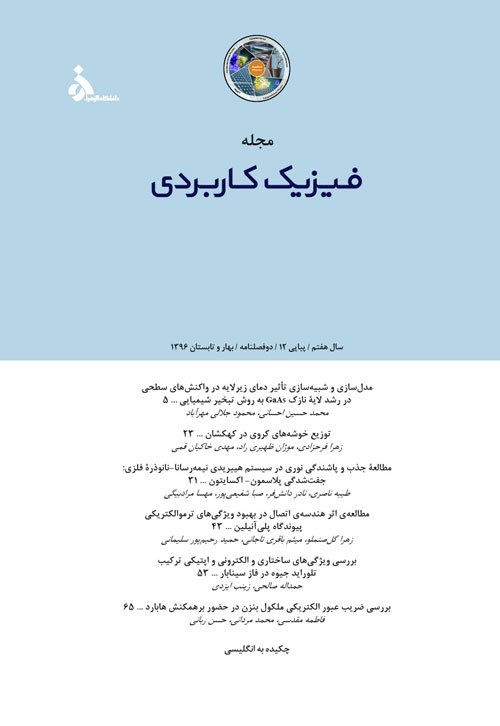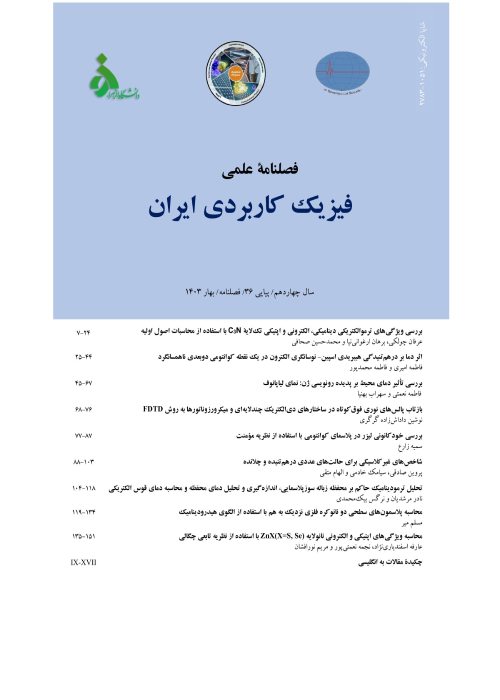فهرست مطالب

مجله فیزیک کاربردی
سال هفتم شماره 1 (پیاپی 12، بهار و تابستان 1396)
- تاریخ انتشار: 1396/02/30
- تعداد عناوین: 6
-
-
صفحات 5-22در این کار، شبیه سازی رشد لایه ی نازکGaAs به کمک روش تبخیر شیمیایی در محیط نرم افزار COMSOL Multiphysics انجام گردیده است. به منظور مقایسه نتایج شبیه سازی با نتایج تجربی، تمامی جزییات شبیه سازی و واکنش های مربوط به تشکیل GaAs بر مبنای یک آزمایش تجربی و نتایج آن صورت گرفت.جزئیات مراحل تعریف واکنش ها، طراحی محفظه، مطالعه روابط شیمیایی و ترمودینامیکی مربوطه و تحلیل مش ها شرح داده شد. پارامتر هایی از قبیل سرعت شار بخار، فشار آن و توزیع دما درون محفظه لایه نشانی مورد بررسی قرار گرفته و به منظور مطالعه و تحلیل، نتایج آن به صورت نمودارهای مناسب ارائه گردید. همچنین وابستگی دمای زیر لایه روی نرخ رشد ماده و الگوی توزیع جرم در نمونه لایه نازک بررسی گردید. با مقایسه ی نتایج شبیه سازی و داده های آزمایشگاهی، علاوه بر بررسی دقت مدل ارائه شده می توان توصیفی مناسب از ارتباط بین نرخ تشکیل لایه با دمای زیر لایه را یافت.کلیدواژگان: تبخیر شیمیایی، نرخ رشد، فیلم نازک، شبیه سازی
-
صفحات 23-30
خوشه های کروی، جمعیت های ستاره ای پیر کهکشان ما هستند که خصوصیات بسیار منحصر به فردی را در ستاره های خود دارند. مواد اولیه ی مشابه، سن یکسان و فاصله ی یکسانی از ما خصوصیاتی هستند که در ستاره های یک خوشه وجود دارد. توزیع خوشه های کروی در کهکشان بسیار جالب است. عمده ی خوشه های کروی در هاله ی کهکشان و مخصوصا در هاله ی اطراف مرکز کهکشان هستند. خوشه های کروی نزدیک به مرکز کهکشان به خاطر نیروی خارجی مرکز کهکشان تحول متفاوتی دارند و سریعتر نیز تبخیر میشوند. به همین خاطر خوشه ی M13 که نسبت به خوشه ی امگا قنطورس نزدیکتر به مرکز کهکشان است از ستاره های کمتر و ابعاد کوچکتری برخوردار است. در این کار توزیع این خوشه ها را در دستگاه مختصات کهکشانی را بدست آوردیم. همچنین لیستی 133 تایی از 150 خوشه کروی کهکشان راه شیری و همچنین درخشانترین آنها در آسمان شمالی و جنوبی که با چشم غیر مسلح قابل رویتند و خصوصیات عمومی آنها را ارائه دادیم.
کلیدواژگان: خوشه های کروی، کهکشان راه شیری، M13، امگا قنطورس -
صفحات 31-42در این مقاله، به بررسی خواص اپتیکی یک سیستم هیبریدی متشکل از یک نیمه رسانای (نقطه کوانتومی) که در مجاورت یک نانو-ذره ی فلزی با تقارن کروی و بیضوی قرار دارد، پرداختهمی شود. جذب و پاشندگی مربوط به میدان الکترومغناطیسی در این سیستم، با استفاده از نظریه نیمه کلاسیکی و از روش ماتریس چگالی بدست آمده و بصورت عددی محاسبه شده اند. در شبیه سازی های عددی، جنس نانوذره از فلزات طلا و نقره انتخاب شده است، زیرا این فلزات گزینه های مناسبی برای کاربردهای پلاسمونیکی در فرکانس های نوری هستند. نشان داده شده است که جذب و پاشندگی نوری به پارامترهایی همچون شکل و اندازه ی ذره، فاصله-ی بین نانوذره و نقطه کوانتومی، و ثابت دی الکتریک محیط اطراف است.لازم به ذکر است که بررسی وابستگی خواص نوری یک سیستم هیبریدی به تغییر و تنظیم پارامترهای هندسی سیستم را می توان برای اهداف حسگری نوری و طراحی نانو زیست حسگرهای تنظیم پذیر بکار برد.کلیدواژگان: جفت شدگی پلاسمون- اکسایتون، جذب و پاشندگی، ماتریس چگالی
-
صفحات 43-52در این مقاله ویژگی های ترموالکتریکی پیوندگاه مولکولی پلی آنیلین را برای سه هندسه ی متفاوت اتصال مولکول به الکترود شامل پارا (متقارن)، متا و اورتو (هر دو نامتقارن) بررسی می کنیم. الکترودهای انتخاب شده مشابه کارهای تجربی سه بعدی و مرکز وجهی می باشند و از رهیافت تابع گرین غیرتعادلی در رژیم پاسخ خطی برای به دست آوردن ضرایب ترموالکتریک استفاده می شود. هامیلتونی سیستم مورد بررسی با استفاده از روش تنگ بست نوشته می شود. نتایج نشان می دهد که هدایت الکتریکی و هدایت گرمایی در اتصال نامتقارن مولکول به الکترودها کاهش می یابد درحالی که توان گرمایی و عدد شایستگی در اتصال های نامتقارن رفتار بهتری را از خود نشان می دهند و در اتصال متا و اورتو دارای افزایش هستند. بنابراین عدم تقارن در اتصال این پیوندگاه مولکولی موجب بهبود کارایی ترموالکتریکی سیستم می شود که یک نتیجه ی مطلوب برای محققین می باشد. از طرف دیگر رفتار نوسانی توان گرمایی نشان می دهد که نوع حامل های شرکت کننده در تونل زنی گرمایی با تغییر مکان ترازهای انرژی مولکولی نسبت به تراز فرمی تغییر می کند.کلیدواژگان: پیوندگاه مولکولی پلی آنیلین، هندسه اتصال، تابع گرین، ویژگی های ترموالکتریکی
-
بررسی ویژگی های ساختاری، الکترونی و اپتیکی ترکیب تلوراید جیوه در فاز سینابارصفحات 53-64در این مقاله خواص ساختاری، الکترونی و اپتیکی ترکیب تلوراید جیوه در فاز هگزاگونال مورد بررسی و مقایسه قرار می گیرد. محاسبات با استفاده از روش شبه پتانسیل در چارچوب نظریه تابعی چگالی و با استفاده از نرم افزار کوانتوم اسپرسو صورت گرفته است. . نتایج ساختار نواری نشان دهندهخاصیت نیم رسانایی این ترکیب در فاز سینابار می باشد. محاسبه سهم حقیقی تابع دی الکتریک ضریب شکست برای فاز سینابار را 489/4 می دهد. نتایج حاصل از سهم موهومی تابع دی الکتریک نشان دهندهمطابقت گاف اپتیکی با گاف نواری می باشد..کلیدواژگان: تلوراید جیوه، فاز هگزاگونال، نظریه تابعی چگالی، خواص اپتیکی
-
صفحات 65-71در این مقاله ضریب عبور الکترونی یک حلقه بنزنی متصل به دو هادی فلزی را در اتصال های پارا و متا، در حضور برهمکنش الکترون الکترون (مدل هابارد) محاسبه می کنیم. برای این منظور از روش تابع گرین و رهیافت تنگ بست در تقریب نزدیک ترین همسایه بهره می جوییم. سپس با توجه به شکل برهمکنش، رسانش را با یک روش عددی خودسازگار به صورت تابعی از انرژی به دست می آوریم. نتایج نشان می دهد که در حضور برهمکنش الکترون الکترون، مکان های قله ها، دره ها و تشدیدهای فانو در طیف رسانش جابجا می شود. مقدار رسانش در انرژی صفر نیز به تغییرات مقدار پارامتر هابارد وابسته است که این امر می تواند منجر به گذار عایق فلز در مورد متا شود. در نظر گرفتن برهمکنش الکترون الکترون با رهیافت خودسازگار، رویکرد واقع بینانه تری نسبت به مدل هایی که در آن این برهمکنش را به صورت تقریب میدان متوسط لحاظ می کنند، دارد.کلیدواژگان: ضریب عبور، تنگ بست، بنزن، هابارد
-
Pages 5-22In this paper, using COMSOL Muliphysics software, GaAs ÝÇåÏ film growth prepared by the chemical vapour deposition Method was simulated. A mixed multiphysics model was used for this purpose. In order to compare the simulation results with those of from experiment, all of the steps and details regarding the GaAs growth reactions were utilized on the basis of an experimental research. Simulation steps including model designing, mesh analysis, chemical and thermodynamic relations and complete sets of chemical Reactions were investigated. Crucial parameters such as the flow rate, pressure and the temperature distribution within the chamber were studied and the graphical results were presented for analyzing.Then, the effect of substrate temperature on growth rate and mass distribution of thin film was investigated. Comparison between the simulation result and experimental data determines the accuracy of the represented model and also provide a promising description for dependency of film growth on substrate temperature.Keywords: CVD Method, Growth Rate, Thin Film, Simulation
-
Pages 23-30
Globular Clusters are the oldest populations of stars of our Galaxy which their stars have unique characteristics. Similar initial mass, equal age and equal distance from us are common characteristics of stars of a cluster. Distribution of the globular clusters is very interesting. Most of them are in galactic halo and specially in halo near to the galactic center. Globular clusters nearer to central part of our galaxy have different evolution respect to others, due to external force of Galactic center. Because of the subject Cluster M13 respect to Omega Centaurs are nearer to galactic center and it has less number and smaller size. In this work we obtained distribution of the globular clusters in galactic coordinates. Meanwhile a list of 133 Globular clusters from 150 ones is presented and the most luminous ones in the north and south sky which are observable by naked eye, and their general characteristics are studied.
Keywords: Globular Clusters, Milky way Galaxy, M13, Omega Centauri -
Pages 31-42In this paper, optical properties of a hybrid system consisting of a semiconductor quantum dot placed in the vicinity of a metal (plasmonic) nanoparticle with spherical and ellipsoidal symmetry is investigated. An analytical expression for the absorption and dispersion using the density-matrix approach via semi-classical theory is derived and numerically discussed. In our numerical calculations, we have used Au and Ag metals, because these metals have predominately been the materials of choice for plasmonic applications around the optical frequencies. It is shown that the optical dispersion and absorption strongly depends on the particle size and shape, the quantum dot-nanoparticle distance (the semiconductor quantum dot-plasmonic nanoparticle center-to-center distance), and the dielectric constant of host matrix. It is important to note that dependences of optical properties of a hybrid system on changing and adjusting of the geometrical parameters of system can be used for optical sensing purposes and design of tunable bio-nanosensors.Keywords: Plasmon-exciting coupling, Absorption, dispersion, Density matrix
-
Pages 43-52In this paper, we investigate thermoelectric properties of polyaniline molecular junction for three different coupling geometries of the coupling of the molecule to the electrodes including para (symmetric), meta and ortho (asymmetric) configurations. The selected electrodes are three dimensional and face center cubic (FCC) similar to the experimental works. The nonequilibrium Green function formalism is used to obtain thermoelectric coefficients in nonlinear response regime. The Hamiltonian of the system is described by tight binding method. The results show, in asymmetric coupling, the electrical conductance and thermal conductance decrease whereas thermopower and figure of merit show better behavior and increase in meta and ortho configurations. Therefore asymmetry in polyaniline molecular junction causes an improvement in thermoelectric efficiency of the junction that is a desirable result for scientists. On the other hand, the oscillating behavior of thermopower indicates the kind of carriers and the place of molecular energy levels relative to the Fermi energy change during the thermal tunneling.Keywords: Polyaniline molecular junction, Coupling geometries, Green function, Thermoelectric properties
-
An investigation of structural, electronic and optical properties of HgTe in cinnabar phasePages 53-64In this paper,the structural, electronic and optical properties of Mercury Telluride (HgTe) in hexagonal phase have been studied. The calculations have been performed with pseudopotantial method in density functional theory framework by using Quantum-Espresso package. It can be seen from band structure calculation that the cinnabar phase has semiconducting property. The calculation of the real part of dielectric function leads to refractive index 4.489 for hexagonal phase.
lculation that the cinnabar phase has semiconducting property. The calculation of the real part of dielectric function leads to refractive index 4.489 for hexagonal phase.Keywords: HgTe, DFT, optical property -
Pages 65-71In this paper, we calculate the electronic transmission coefficient of a benzene ring connected to two metallic leads via the para and meta contacts in the presence of electron-electron interaction (Hubbard model). For this purpose, we use the Greens function technique and the nearest neighbor tight-binding approach. Then, we obtain the electronic conductance as a function of energy by a numerical self-consistent method due to the shape of interaction. The result show that in the presence of the electron-electron interaction, the positions of peaks, dips and Fano resonances which are appeared in the conductance spectra will be shifted. Moreover, the value of the conductance at zero energy strongly depends on variation of the Hubbard parameter value; which leads to the metal-insulator transition in the meta case. Considering of the electron - electron interaction within the self-consistent approach gives a realistic viewpoint with respect to the models in which this interaction is considered by the mean field approximation.Keywords: transmission coefficient, tight-binding, benzene, Hubbard


